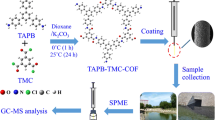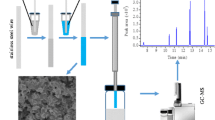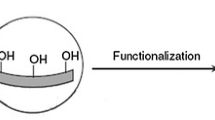Abstract
A solid-phase microextraction (SPME) fiber coated with a hollow microporous organic network (H-MON) was fabricated for the analysis of short-chain chlorinated paraffins (SCCPs). The sorbent was prepared by reacting tetra(4-ethynylphenyl)methane and 1,4-diiodobenzene using bis-(triphenylphosphine) palladium(II) as the catalyst in the presence of silica sphere templates, which then were removed by hydrofluoric acid. The SCCPs were quantified by GC-MS working in the negative chemical ionization mode. The H-MON has a high specific surface (701 m2·g−1) and microporosity (pore size <2 nm). Extraction temperature, extraction time, and ionic strength of the sample solutions were optimized by using the Box-Behnken design. The head-space SPME exhibits better extraction performance than the direct immersion mode. Under optimal working conditions, the detection limit (3 times of the standard deviation) is 0.03 ng·mL−1 in the water samples. Response is linear in the 0.05–10 ng·mL−1 concentration range. Repeatability and reproducibility, expressed as the relative standard deviations, ranged from 4.6 to 11.0%. The method was successfully applied in the analysis of SCCPs in water, sediments, organisms, and atmospheric particulate matter samples.

Schematic of the fabrication of a hollow microporous organic network (H-MON) on stainless steel fibers for use in SPME. The method was applied to the determination of short-chain chlorinated paraffins in biological, environmental water and atmospheric particulate matter (PM2.5) samples.




Similar content being viewed by others
References
Arthur CL, Pawliszyn J (1990) Solid phase microextraction with thermal desorption using fused silica optical fibers. Anal Chem 62:2145–2148
Spietelun A, Kloskowski A, Chrzanowski W, Namiesnik J (2013) Understanding solid-phase microextraction: key factors influencing the extraction process and trends in improving the technique. Chem Rev 113:1667–1685
Souza-Silva EA, Jiang R, Rodriguez-Lafuente A, Gionfriddo E, Pawliszyn J (2015) A critical review of the state of the art of solid-phase microextraction of complex matrices I. Environmental analysis. Trends Anal Chem 71:224–235
Souza-Silva EA, Gionfriddo E, Pawliszyn J (2015) A critical review of the state of the art of solid-phase microextraction of complex matrices II. Food analysis. Trends Anal Chem 71:236–248
Souza-Silva EA, Reyes-Garces N, Gomez-Rios GA, Boyaci E, Bojko B, Pawliszyn J (2015) A critical review of the state of the art of solid-phase microextraction of complex matrices III. Biological analysis. Trends Anal Chem 71:249–264
Ouyang GF, Vuckovic D, Pawliszyn J (2011) Nondestructive sampling of living systems using in vivo solid-phase microextraction. Chem Rev 111:2784–2814
Gu ZY, Yang CX, Chang N, Yan XP (2012) Metal-organic frameworks for analytical chemistry: from sample collection to chromatographic separation. Acc Chem Res 45:734–745
Xu J, Zheng J, Tian J, Zhu F, Zeng F, Su C, Ouyang G (2013) New materials in solid-phase microextraction. Trends Anal Chem 47:68–83
Bagheri H, Manouchehri M, Allahdadlalouni M (2017) A magnetic multifunctional dendrimeric coating on a steel fiber for solid phase microextraction of chlorophenols. Microchim Acta 184:2201–2209
Wang W, Li Z, Wang W, Zhang L, Zhang S, Wang C, Wang Z (2017) Microextraction of polycyclic aromatic hydrocarbons by using a stainless steel fiber coated with nanoparticles made from a porous aromatic framework. Microchim Acta 185:20–30
Wu T, Wang J, Liang W, Zang X, Wang C, Wu Q, Wang Z (2017) Single layer graphitic carbon nitride-modified graphene composite as a fiber coating for solid-phase microextraction of polycyclic aromatic hydrocarbons. Microchim Acta 184:2171–2180
Tomy GT, Stern GA, Muir DCG, Fisk AT, Cymbalisty CD, Westmore JB (1997) Quantifying C10-C13 polychloroalkanes in environmental samples by high-resolution gas chromatography/electron capture negative ion high-resolution mass spectrometry. Anal Chem 69:2762–2771
Bayen S, Obbard JP, Thomas GO (2006) Chlorinated paraffins: a review of analysis and environmental occurrence. Environ Int 32:915–929
Huang H, Gao L, Xia D, Qiao L, Wang R, Su G, Liu W, Liu G, Zheng M (2017) Characterization of short- and medium-chain chlorinated paraffins in outdoor/indoor PM10/PM2.5/PM1.0 in Beijing, China. Environ Pollut 225:674–680
Qiao L, Gao L, Xia D, Huang H, Zheng M (2017) Short- and medium-chain chlorinated paraffins in sediments from the middle reaches of the Yangtze River: spatial distributions, source apportionment and risk assessment. Sci Total Environ 575:1177–1182
Zeng L, Wang T, Wang P, Liu Q, Han S, Yuan B, Zhu N, Wang Y, Jiang G (2011) Distribution and trophic transfer of short-chain chlorinated paraffins in an aquatic ecosystem receiving effluents from a sewage treatment plant. Environ Sci Technol 45:5529–5535
Ma X, Zhang H, Wang Z, Yao Z, Chen J, Chen J (2014) Bioaccumulation and trophic transfer of short chain chlorinated paraffins in a marine food web from Liaodong Bay, North China. Environ Sci Technol 48:5964–5971
UNEP (2017) Stockholm convention on persistent organic pollutants. eighth meeting May
Castells P, Santos FJ, Galceran MT (2004) Solid-phase extraction versus solid-phase microextraction for the determination of chlorinated paraffins in water using gas chromatography–negative chemical ionisation mass spectrometry. J Chromatogr A 1025:157–162
Zhou Y, Yin G, Du X, Xu M, Qiu Y, Ahlqvist P, Chen Q, Zhao J (2018) Short-chain chlorinated paraffins (SCCPs) in a freshwater food web from Dianshan Lake: occurrence level, congener pattern and trophic transfer. Sci Total Environ 615:1010–1018
Eljarrat E, Barcelo D (2006) Quantitative analysis of polychlorinated n-alkanes in environmental samples. TrAC Trends Anal Chem 25:421–434
Castells P, Santos FJ, Galceran MT (2003) Solid-phase microextraction for the analysis of short-chain chlorinated paraffins in water samples. J Chromatogr A 984:1–8
Gandolfi F, Malleret L, Sergent M, Doumenq P (2015) Parameters optimization using experimental design for headspace solid phase micro-extraction analysis of short-chain chlorinated paraffins in waters under the European water framework directive. J Chromatogr A 1406:59–67
Chun J, Kang S, Kang N, Lee SM, Kim HJ, Son SU (2013) Microporous organic networks bearing metal-salen species for mild CO2 fixation to cyclic carbonates. J Mater Chem A 1:5517
Kang N, Park JH, Jin M, Park N, Lee SM, Kim HJ, Kim JM, Son SU (2013) Microporous organic network hollow spheres: useful templates for nanoparticulate co3o4 hollow oxidation catalysts. J Am Chem Soc 135:19115–19118
Ko JH, Kang N, Park N, Shin H-W, Kang S, Lee SM, Kim HJ, Ahn TK, Son SU (2015) Hollow microporous organic networks bearing triphenylamines and anthraquinones: diffusion pathway effect in visible light-driven oxidative coupling of benzylamines. ACS Macro Lett 4:669–672
Jia Y, Su H, Wang Z, Wong YE, Chen X, Wang M, Chan TD (2016) Metal-organic framework@microporous organic network as adsorbent for solid-phase microextraction. Anal Chem 88:9364–9367
Chinchilla R, Na’jera C (2007) The Sonogashira reaction: a booming methodology in synthetic organic chemistry. Chem Rev 107:874–922
Stober W, Fink A (1968) Controlled growth of monodisperse silica spheres in the micron size range. J Colloid Interface Sci 26:62–69
Reth M, Zencak Z, Oehme M (2005) New quantification procedure for the analysis of chlorinated paraffins using electron capture negative ionization mass spectrometry. J Chromatogr A 1081:225–231
Reth M, Oehme M (2004) Limitations of low resolution mass spectrometry in the electron capture negative ionization mode for the analysis of short- and medium-chain chlorinated paraffins. Anal Bioanal Chem 378:1741–1747
Jiang JX, Su F, Trewin A, Wood CD, Campbell NL, Niu H, Dickinson C, Ganin AY, Rosseinsky MJ, Khimyak YZ, Cooper AI (2007) Conjugated microporous poly (aryleneethynylene) networks. Angew Chem 119:8728–8732
Yang S, Li Y, Wang S, Wang M, Chu M, Xia B (2018) Advances in the use of carbonaceous materials for the electrochemical determination of persistent organic pollutants. A review. Microchim Acta 185:112
Chaemfa C, Xu Y, Li J, Chakraborty P, Hussain Syed J, Naseem Malik R, Wang Y, Tian C, Zhang G, Jones KC (2014) Screening of atmospheric short- and medium-chain chlorinated paraffins in India and Pakistan using polyurethane foam based passive air sampler. Environ Sci Technol 48:4799–4808
Acknowledgements
Financial supports from the National Natural Science Foundation of China (21777089), Natural Science Foundation of Shandong Province (ZR2018MB040),Key Research and Development Program of Shandong Province (2017GSF17107, 2017CXGC0223 and 2018GSF117036), Fundamental Research Funds of Shandong Academy of Sciences, and Funds for Fostering Distinguished Young Scholar of Shandong Academy of Sciences are gratefully acknowledged.
Author information
Authors and Affiliations
Corresponding author
Ethics declarations
The author (s) declare that they have no competing interests.
Electronic supplementary material
ESM 1
(DOCX 985 kb)
Rights and permissions
About this article
Cite this article
Li, J., Li, H., Zhao, Y. et al. A hollow microporous organic network as a fiber coating for solid-phase microextraction of short-chain chlorinated hydrocarbons. Microchim Acta 185, 416 (2018). https://doi.org/10.1007/s00604-018-2955-7
Received:
Accepted:
Published:
DOI: https://doi.org/10.1007/s00604-018-2955-7




